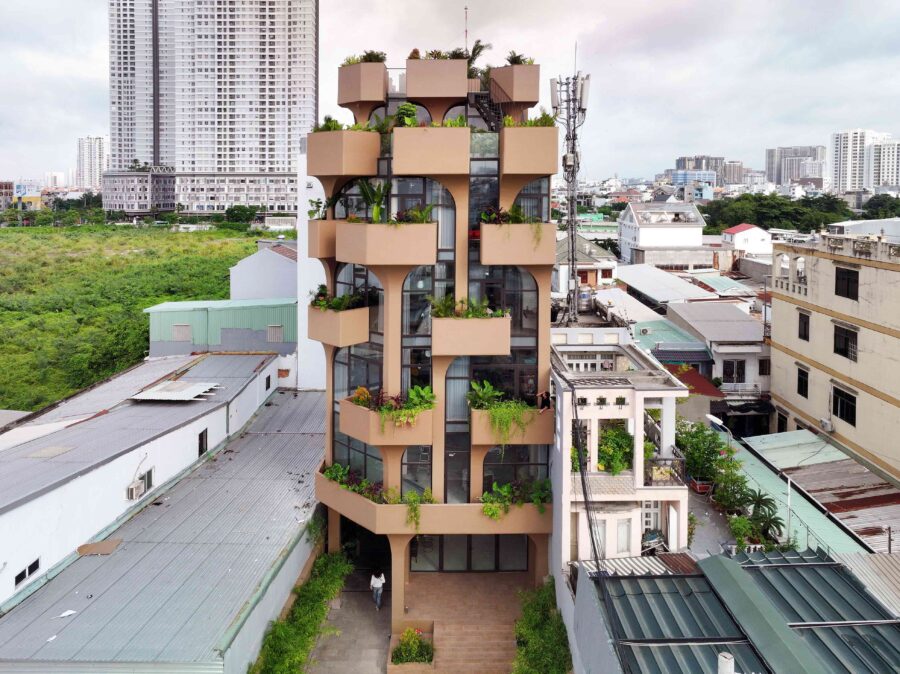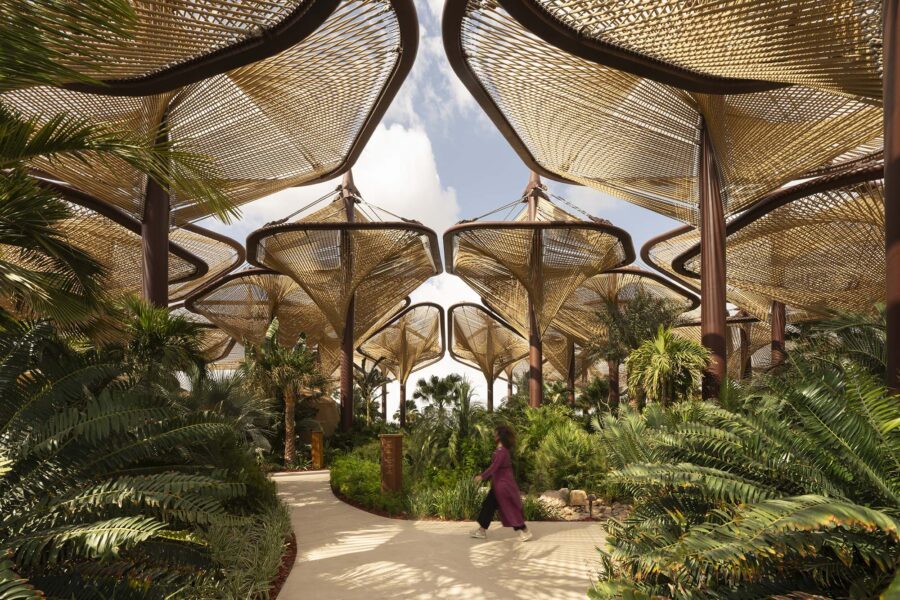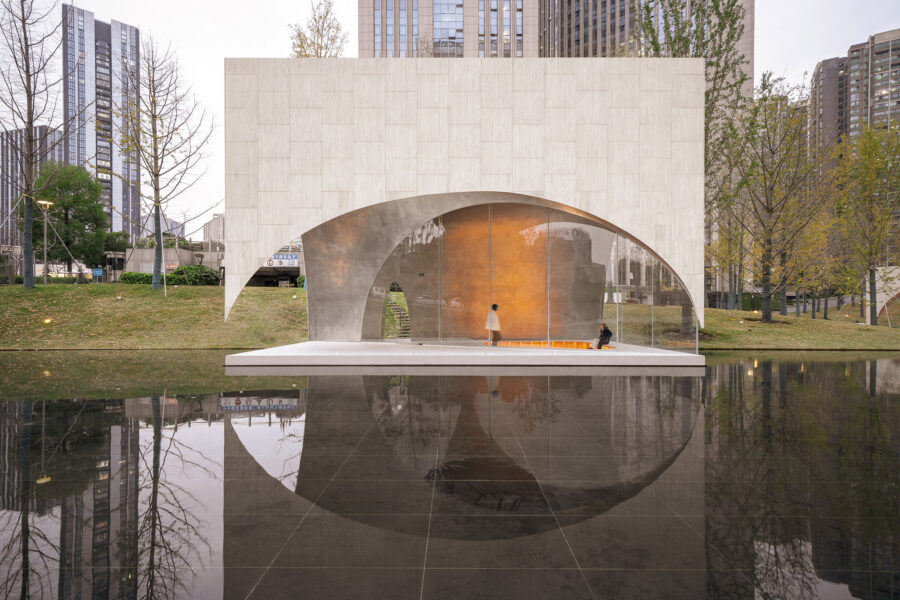
CULTURE

フランス、リヨンのホルシム・イノベーション・ハブに建設された〈Phoenix〉は、2021年のベネチア建築ビエンナーレにて発表された、乾式で組み上げる世界初の3Dプリントコンクリート橋〈Striatus〉の進化形であり、CO2排出量を40%削減、構造全体のカーボンフットプリントは25%削減、使用する材料を最大50%削減することが可能となっています。
ザハ・ハディド・アーキテクツ コンピュテーション&デザイングループ(ZHACODE)とホルシム(Holcim)、チューリッヒ工科大学(ETHZ)ブロックリサーチグループ、インクリメンタル3D(incremental3D)による共同プロジェクトです。
(以下、Zaha Hadid Architectsから提供されたプレスキットのテキストの抄訳)

© Block Research Group
乾式で組み上げる〈Striatus〉を進化させた、新たな3Dプリントコンクリート橋
〈Phoenix〉は、2021年のベネチア建築ビエンナーレにて発表された、世界初の3Dプリントコンクリート橋〈Striatus〉の進化形である。〈Striatus〉におけるイノベーションを基に、〈Phoenix〉は〈Striatus〉のオリジナルのブロックからリサイクルされた骨材を含む10トンのリサイクル材料で建設されている。
世界90カ国以上でセメント、骨材、コンクリート等の製造・販売を行うホルシムは、独自の循環技術プラットフォームであるECOCycle®を駆使し、〈Phoenix〉のためのコンクリート・インクを開発した。

© Block Research Group
最適化された配合により、2021年の〈Striatus〉と比較してCO2排出量を40%削減し、構造全体のカーボンフットプリントは25%削減している。
コンピュテーショナルデザインと3Dプリントを用いた循環型の建設により、性能に妥協することなく、使用する材料を最大50%削減することが可能となった。〈Phoenix〉は補強材を使わず圧縮のみで自立するため、ブロックは容易に解体・リサイクルすることができる。

© incremental3D
コラボレーションにより実現する、「3Dプリント × 循環型建設」のマイルストーン
リヨンにあるホルシム・イノベーション・ハブに建設された〈Phoenix〉は、ホルシム、チューリッヒ工科大学のブロックリサーチグループ、ザハ・ハディド・アーキテクツ コンピュテーショナルデザイングループ(ZHA CODE)、インクリメンタル3Dによる共同プロジェクトである。
〈Phoenix〉は、3Dコンクリート・プリントを組み合わせた循環型の建設が大幅な炭素削減をもたらすことを実証するものであり、あらゆる規模の低炭素構造ソリューションの開発に取り組むホルシムとそのパートナーによる最新のマイルストーンである。
海外にみる 3Dプリント建築2.0 | 住宅供給や既存の技術を革新する 3Dプリントを通して未来を見据えるプロジェクト10選

© Holcim
「〈Phoenix〉は、共通の目標を達成するためのパートナー達との協力の成果であり、生活に必要不可欠なインフラが、循環型で低炭素な方法で設計・建設できることを実証している。このプロジェクトは、ネット・ゼロの未来のために建物を脱炭素化するというホルシムのミッションにおいて、イノベーションがもたらしうるインパクトを示すものである。」
─ ホルシム グローバルR&D責任者、エデリオ・ベルメホ(Edelio Bermejo)
「コンクリートは人工の石であり、石と同じようにまっすぐな梁になることを望まず、石積みのアーチになることを望んでいる。このような歴史的な原則に従うことで、リサイクルしやすいように材料を分離、解体、再利用しやすいように構造を乾式で組み立てることができる。必要な場所に必要なだけを正確に使用することができる3Dコンクリート・プリントによって、コンクリート建設に対する持続可能で真に循環的なアプローチが実現したのである。」
─ チューリッヒ工科大学 ブロックリサーチグループ共同ディレクター、フィリップ・ブロック(Philippe Block)

© Block Research Group
「〈Phoenix〉は、テクノロジーへの対応における重要なマイルストーンであり、〈Striatus〉から始まった、設計から施工までの統合技術の成熟を示すものである。デジタル・デザイン・ツールの堅牢性が向上し、構造設計やサーキュラリティに関連する数多くの改善点との整合性が緊密になり、ロボットによるコンクリート印刷パラメータとの統合が強化され、より少ない印刷時間でほぼ2倍のブロック数の生産効率を改善するための大規模なキャリブレーションが行われた。」
─ ザハ・ハディド・アーキテクツ ZHA CODE責任者、シャジェイ・ブーシャン(Shajay Bhooshan)
「〈Striatus〉は、その設計理念により、3Dコンクリート・プリントを最も純粋な形で表現している。その2年後、2度目の反復を行った今、〈Phoenix〉はカーボンフットプリントを大幅に削減するだけでなく、建築法規に従った永続性を追加するなど、さらに多くの改良が加えられた。その結果、我々incremental3dチームは〈Phoenix〉に非常に大きな期待を寄せており、同様の精神で進化する他の多くのプロジェクトを楽しみにしてしている。」
─ インクリメンタル3D共同創設者、ヨハネス・メーゲンス(Johannes Megens)

© Block Research Group
以下、Zaha Hadid Architectsのリリース(英文)です。
Phoenix: the new 3D-printed concrete bridge
Holcim Innovation Hub in Lyon, FranceThe new Phoenix bridge represents the evolution of the Striatus, the first-of-its-kind 3D-printed concrete bridge presented during the 2021 Venice Architecture Biennale.
Building on the innovations of the Striatus bridge, Phoenix is constructed from 10 tons of recycled materials, including recycled aggregates from the original blocks of Striatus. Using its ECOCycle® circular technology, Holcim developed a proprietary concrete ink for Phoenix that incorporates an optimized low-carbon formulation with a 40% lower CO2 footprint compared to the 2021 Striatus bridge and an overall carbon footprint that is 25% lower than the original structure.
Circular construction, using computational design and 3D printing, allows for a reduction of up to 50% of the materials used with no compromise in performance. Circular by design, Phoenix stands solely through compression without reinforcement, with blocks that can be easily disassembled and recycled.
Constructed at Holcim’s Innovation Hub, in Lyon, Pheonix is a collaboration between Holcim, Block Research Group at ETH Zurich, Zaha Hadid Architects Computation and Design Group (ZHA CODE) and incremental3D. Demonstrating circular construction combined with 3D concrete printing offers significant carbon reductions, the Pheonix bridge is the latest milestone by Holcim and its partners in their work to develop low-carbon structural solutions at every scale.
Edelio Bermejo, Head of Global R&D, Holcim: “I am thrilled to unveil Phoenix, the result of a fruitful collaboration with our partners to meet a common goal: demonstrating that essential infrastructure can be designed and built in a way that is circular and low-carbon today. This project showcases the impact that innovation can have in Holcim’s mission to decarbonize building for a net-zero future.”
Philippe Block, Co-Director, Block Research Group at ETH Zurich: “Concrete is an artificial stone, and like stone, it does not want to be a straight beam, it wants to be a masonry arch. Following these historical principles allows us to keep materials separated for easy recycling and to dry-assemble the structure for easy deconstruction and reuse. 3D concrete printing allows us to use material only and exactly where needed. The result is a sustainable and truly circular approach to concrete construction.”
Shajay Bhooshan, Head of Computation and Design Group, Zaha Hadid Architects: “Phoenix is a significant milestone in technology readiness. It showcases the maturation of integrated design to construction technologies that were initiated with Striatus. There have been improvements in the robustness of the digital design tools, closer alignment with the numerous structural design and circularity-related improvements, tighter integration with robotic concrete printing parameters and extensive calibration to improve efficiency of production of almost double the number of blocks in less printing time.”
Johannes Megens, Co-Founder, incremental3D: “Thanks to its design principles, Striatus already represented 3D concrete printing in its purest possible form. Now, after two years and in its second iteration, Phoenix adds a largely reduced carbon footprint and permanence according to building codes along with many other further improvements. Consequently we, the incremental3d team, are very excited about Phoenix and we are looking forward to many other projects that will evolve in similar spirit.”
Striatus Development Team (2021)
Design
ZHA CODE: Jianfei Chu, Vishu Bhooshan, Henry David Louth, Shajay Bhooshan, Patrik Schumacher
ETH BRG: Tom Van Mele, Alessandro Dell’Endice, Philippe Block
Structural Engineering
ETH BRG: Tom Van Mele, Alessandro Dell’Endice, Sam Bouten, Philippe BlockFabrication design
ETH BRG: Shajay Bhooshan, Alessandro Dell’Endice, Sam Bouten, Chaoyu Du, Tom Van Mele
ZHACODE: Vishu Bhooshan, Philip Singer, Tommaso Casucci3D concrete printing
In3D: Johannes Megens, Georg Grasser, Sandro Sanin, Nikolas Janitsch, Janos MohacsiConcrete material development
Holcim: Christian Blachier, Marjorie Chantin-Coquard, Helene Lombois-Burger, Francis Steiner
LafargeHolcim Spain: Benito Carrion, Jose Manuel ArnauAssembly & Construction
Bürgin Creations: Theo Bürgin, Semir Mächler, Calvin Graf
ETH BRG: Alessandro Dell’Endice, Tom Van Mele
「Phoenix」Zaha Hadid Architects 公式サイト
https://www.zaha-hadid.com/2024/01/05/phoenix-the-new-3d-printed-concrete-bridge/









